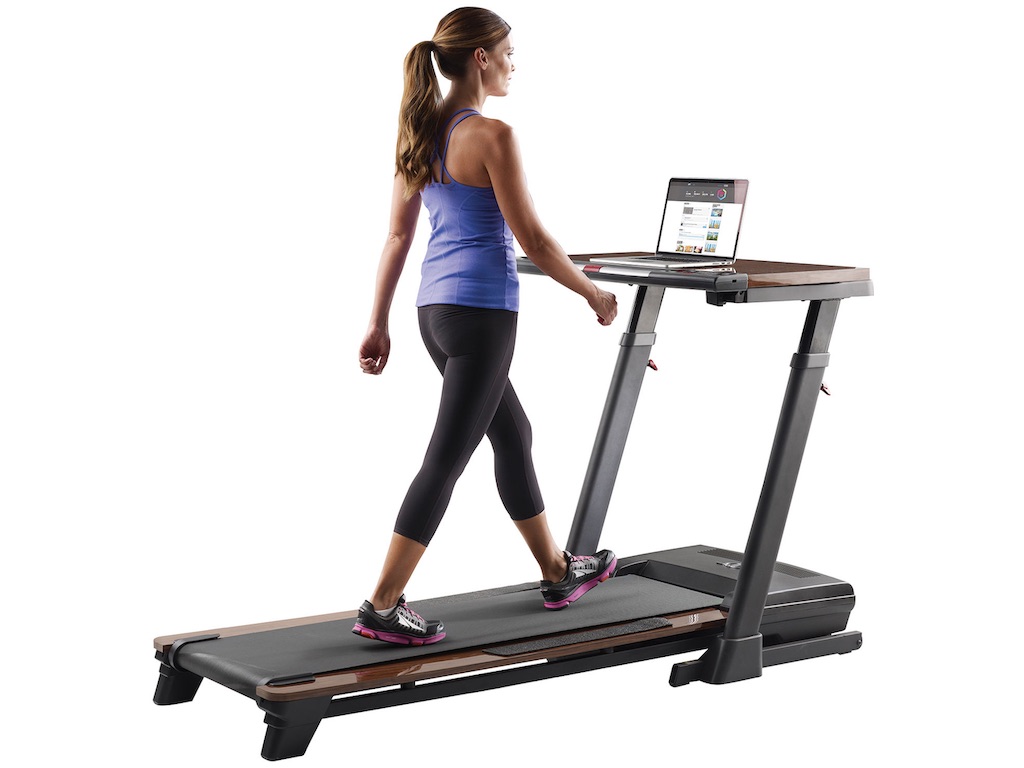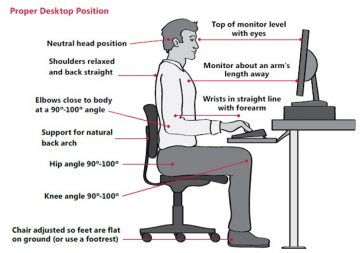
Here’s a question for you, and a timely one with new Year’s Eve and its (frequently) fitness-themed resolutions fast approaching: how can a computer help you keep fit? I was pondering that question recently. There are the usual answers, like using a web browser to look up nutritional information, using a spreadsheet to track your daily exercise, or connecting a Fitbit to your PC to track your activities and health stats. But all those can be done using a smartphone app—and usually more easily.
I was thinking about the current focus on exercise and fitness. Much of the finger pointing these days is around spending long hours sitting at a desk instead of moving around, or at least standing. And why do we do that? Because we’re working on a computer! So instead of a list of ways a computer can help you keep fit, instead I’ve put together a list of five tips for healthier computer use.
Get up and move around, maybe even consider a standing desk
From a health and fitness perspective, the big argument against sitting all day in front of a computer is the sitting part.
 That can be remedied. The trendy move is to switch to a standing desk. I can understand the appeal of these. There are models with integrated mounts for multiple monitors (because you’ll need to raise those as well), and easily adjustable height. There are also add-on stands for an existing desk. The nice thing about height adjustment is that you can have all the benefits of a standing desk, but then flip a switch or turn a crank (more exercise!) to lower it back down and enjoy a few minutes of old school sitting.
That can be remedied. The trendy move is to switch to a standing desk. I can understand the appeal of these. There are models with integrated mounts for multiple monitors (because you’ll need to raise those as well), and easily adjustable height. There are also add-on stands for an existing desk. The nice thing about height adjustment is that you can have all the benefits of a standing desk, but then flip a switch or turn a crank (more exercise!) to lower it back down and enjoy a few minutes of old school sitting.
As someone who sits all day and then some, writing, I have a few variations of the standing desk. I jury-rigged my own treadmill desk a few years back. That works pretty well and has the added bonus of actually adding exercise to the mix instead of passively standing. I also have a standing desk that mounts to a window with industrial strength suction cups. I’m sure it entertains my neighbours, but it too works—and better than you might think.
However, I still prefer sitting at my desk to work. The concession I’ve made over the years is to do everything possible to keep moving. When it comes to getting up, I make a point of not multitasking. When I let the dogs out, I don’t also take out the recycling. I make separate trips for everything, so I’m up and moving every 30 minutes or so. I moved the coffee maker out of my office as well, so I have to go downstairs every time I want a coffee. You can set reminders on your smartphone, smartwatch—or computer—to get up and move, but I’ve found my natural rhythm of seeing kids off to school, having them home for lunch, dealing with couriers, letting out dogs and fetching coffee keeps me moving.
 Choose a good chair
Choose a good chair
If you’re going to be sitting at a desk all day, the best thing you can do for your back is to invest in a proper office chair. I use an Ergohuman chair that represents a bit of an investment, but has been worth every penny. It is infinitely adjustable, incredibly comfortable and looks pretty cool, too. On top of that, it has lasted a decade now—double the length of time my last chair held up for.
Make sure you have a good monitor, adjust its height, and use its features

Outside of the health issues related to lack of activity, and the risk of injuring your back and/or neck from sitting in a subpar chair, one of the big areas of concern around staring at a computer screen all day is the screen itself.
I wrote a pretty detailed post a few years back about preventing eyestrain and those points apply here. In particular, pay attention to the height of your computer’s display in relationship to your eyes. Also important to take into account are the size and resolution of the display—squinting all day at a 15-inch laptop display is easily remedied by plugging it into a 30-inch high resolution display. And many current monitors offer eye-friendly technology such as reduced blue light emission, and reduced flicker.
Pay attention to lighting
Once factor that many people fail to account for when setting up their computer is lighting. You don’t want to be working in the dark, but at the same time you don’t want to be dealing with bright lights reflected off your computer screen.
Choose a desk light that suits your setup and needs. Position the lighting to avoid glare. I’d recommend choosing an LED light with adjustable brightness and colour temperature.
A good keyboard and mouse to keep RSI away
The other big health and fitness concern when it comes to frequent computer use is RSI, or Repetitive Strain Injuries. These typically happen because of the position of the hands and wrists when typing and using a mouse, resulting in injuries like carpal tunnel syndrome. RSIs can be painful. They can also cause lasting damage that requires wearing a special brace or even surgery to correct. The best course of action is to avoid the RSI in the first place.

Laptops come with keyboards that are built-in and thus can’t really be adjusted. Most PCs come with a pack-in keyboard and mouse (usually wired) that are seldom considered world class. I would suggest picking a good quality wireless keyboard and mouse. Ideally the keyboard should have height/typing angle adjustment and a wrist rest. Backlit is even better, making it easier to see those keys in dim light. Going wireless reduces clutter, but also makes it easy to position the keyboard and mouse ergonomically to reduce your RSI risk.
So there you have it, my five tips for more healthy computer use. Naturally you can find not just the computer, but all the gear I’ve suggested at Best Buy. If you have any hot tips for making using a computer healthier, please feel free to share them in the comments.




very good
Comments are closed.